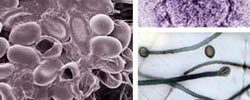Microbes contaminate our air and water. They cause infectious and communicable diseases. Much of the work in public health involves identifying these microbes and finding ways to prevent their adverse effect on society.
"Microbiology: An Introduction" provides a very brief introduction to microbiology. After taking this course, the learner will have a general understanding of cell biology and a better understanding of the five microbial groups that are of concern to the public health practitioner: bacteria, fungi, protozoa, helminths (worms), and viruses. The course may be used as either a refresher for people with backgrounds in microbiology or as a primer for public health professionals with little background in the subject.
This course is a prerequisite for "Microbiology and Communicable Disease," a module of the Basic Environmental Health Program (BEHP) required for local health department sanitarians and public health technicians working in New York State.
Learning Outcome
As a result of this activity the learner will enhance their knowledge and competence of cellular biology and the five microbial groups that are of significance to public health professionals.
Objectives
After completing this course, the learner will be able to:
- Describe the basic characteristics of these live microbial groups: bacteria, fungi, protozoa, helminthes and viruses.
- Describe the public health significance of the five microbial groups.
Continuing Education Credits
Generic Continuing Education Credits
1.0 hours of Generic Continuing Education Credits.
- Training launched: September 1, 2004
- Estimated time: 2–3 hours
- Training is free and open to the public
The planners, moderator, and presenters do not have any financial arrangements or affiliations with any ineligible companies whose products, research, or services may be discussed in this activity.
No commercial funding has been accepted for this activity.
